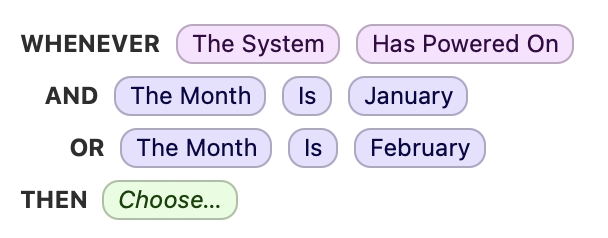CueServer offers the ability to trigger actions based on Global events, such as a button press, system startup, or a DMX signal being detected or lost.
Global Rules are configured using the Global Rules section of the TRIGGERS group within CueServer Studio.

When chosen, the top of the editor panel will show the Global Rules listing:
Each column of the list is described below:
- Number – The numerical order of the list.
- Name – The name given to each Global Rule.
- Details – A summary of the defined trigger and action.
The 

The 
- Duplicate Rule… – Used to make a copy of an existing rule.
- Refresh – Used to reload the list of Global Rules.
Properties
When creating or editing a selected Global Rule, three fields will appear in the properties pane below the list:
- Number – The rule number is used to order the rule in the list above. If creating a rule, this field will automatically be populated with the next sequential number available.
- Name – The name property is to help identify each rule’s purpose at a glance.
- Rule – The rule describes the event that acts as the rule’s trigger, and the action(s) that should take place.
Building a Rule
A rule is structured to describe a sequence:
WHENEVER something happens → AND a condition is met → THEN do something
In the case of global rules, there are 4 general components:
- Entity – the thing that something happens to
- Event / Trigger – the something that happens
- Condition – optional condition(s) that must be met
- Action – the something to be done
Entity
Click on the 
- The System
- The Show
- Button
- Contact
- Control
- DMX Universe
- DMX Port
In some cases, such as with Buttons, there may be multiple instances. In these cases, a field will appear to define the specific instance.
Event
Choose the event / trigger for the rule. The available events depend on the chosen entity.
| Entity | Events |
|---|---|
| The System | Has Powered On Is Powering Off |
| The Show | Has Loaded Will Be Unloaded |
| Button (n) | Is Pressed Is Held Is Released |
| Contact (n) | Is Opened Is Closed Is Held |
| Control (n) | Is Pressed Is Held Is Released |
| DMX Universe (n) | Begins Receiving Data Stops Receiving Data |
| DMX Port (n) | Begins Receiving Data Stops Receiving Data |
Condition(s)
One ore more conditions can be added to an event. Hover over the end of a line the in the rule list to show the add AND button ( ).
The following options are available:
- The Time
- The Hour
- The Minute
- The Second
- The Date
- The Month
- The Day
- The Year
- The Sun Brightness
- Button
- Contact
- Indicator
- Output
- Variable
Each of the above options contain various configurations and/or fields to describe the condition.
Additionally, conditions can have OR statements. For example, AND The Month Is January OR The Month Is February. To add an OR statement to a condition, hover over the end of the condition and press the add OR button ( ).
Action(s)
Use the 
The following actions are available:
- Perform CueScript
- Perform Macro
- Execute Cue
- Next Cue
- Update Cue
- Select Playback
- Clear Playback
- Set Submaster
- Set Channel
- Set Group
- Release Channel
- Release Group
- Activate Preset
- Toggle Preset
- Deactivate Preset
- Update Preset
- Set Indicator
- Set Output
- Set Variable
- Send String
Rules can also have more than one action and are executed in the order that they are listed. Hover over the end of an action in the rule list to show the add THEN button ( 
In some cases you may need to change a rule to CueScript in order to accomplish a more-complex action, or add special cases.
You can convert an action into CueScript automatically by hovering over the end of the action, selecting the menu button ( ), and then selecting Convert to CueScript from the menu.





